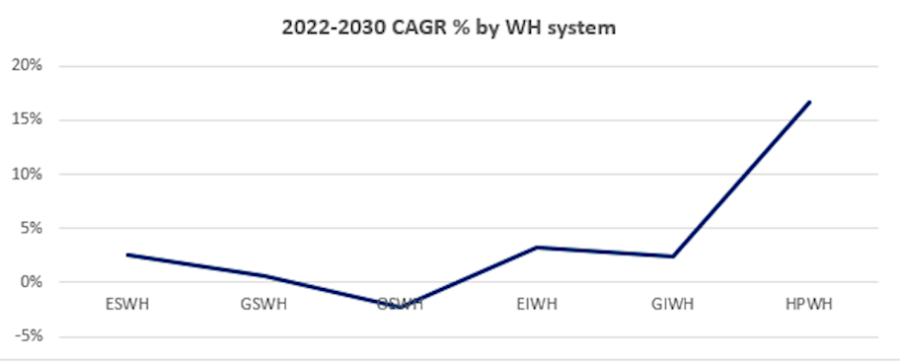Global water heating market shifts gear

|
| Article written by George Laganas |
[edit] Renewables Surge, Traditional Systems Sputter
The current energy crisis has added pressure on governments to accelerate their green initiatives in space and water heating technologies. It will therefore come as no surprise that our analysis of the global water heating markets found that heat pumps, electric storage, and instantaneous water heaters recorded the biggest growth in 2023 and the forecasted period.
2023 saw traditional water heating systems grow by 1.5% globally, whereas water heaters powered by renewable sources (i.e. heat pump water heaters) reported an impressive growth of 21.3% (vs 2022). Our analysis showed that end-users are increasingly replacing gas systems with electricity storage or instantaneous units, given the ever-growing spark gap in most economies. Oil-fuelled water heaters are declining, as they are banned from most markets, with some exceptions for remote areas off the gas grid. Nonetheless, there are certain countries that still permit oil water heaters, but they do so under the condition that a renewable source of heating works alongside them; hence ensuring partial sustainable output.
The above graph depicts the CAGR % for each water heating system from 2022 to 2030. Besides oil-fuelled systems that are in decline, gas storage water heaters note the lowest growth (below 1%). Middle East and Africa still rely on these types of systems, so slight growth is seen in this region. Electric storage water heaters also note a CAGR of 4.5%. However, in Europe gas storage systems are forecasted to decline by almost 5% by 2030 and electric storage water heaters note a marginal growth of 1.3%, for the same period.
Instantaneous water heating systems show a different global picture. In all researched regions, we found that electric instantaneous water heating systems are growing at a faster rate than gas instantaneous systems. The Americas show a 3.3% CAGR (2022-2030) for EIWH and 2.1% for GIWH. Europe’s CAGR for EIWH is marked at 2.7% yet GIWH are in decline with CAGR -2.9% for the same period.
Heat pump water heaters note the biggest potential globally, with almost 17% CAGR for the period 2022-2030. The Americas and Asia & Oceania hold the biggest participation in this market, with over 20% CAGR, whilst Europe notes a 12% CAGR, albeit representing the most advanced market worldwide when it comes to renewables and sustainable sources of energy. Middle East & Africa are not regions we find heat pumps established, as they still rely on traditional systems to heat space and water.
Solar-Thermal water heating saw a slight growth in 2023 versus 2022; however, the future outlook seems much more promising with an overall CAGR 2022-2030 at 3%. Middle East & Africa are the regions that invest the most in ST systems, benefitting from the local climate.
This article appears on the BSRIA news and blog site as 'Global Water Heating Market Shifts Gear: Renewables Surge, Traditional Systems Sputter' dated January 2024 and was written by George Laganas.
--BSRIA
[edit] Related articles on Designing Buildings
- Aaron Gillich, Professor of Building Decarbonisation and Director of the BSRIA LSBU Net Zero Building Centre.
- Building services.
- BSRIA seminar on knowledge to achieve a net zero future. March 2023
- BSRIA topic guide to thermal comfort TG22 / 2023. February 2023
- Combustion plant.
- Heat pump.
- Heat pumps and heat waves: How overheating complicates ending gas in the UK.
- Heating controls.
- Heating large spaces.
- Heating.
- Hot water.
- Hot water safety.
- HVAC.
- Low carbon heating and cooling.
- Net zero building centre with BSRIA and LSBU.
- Pipework.
- Radiant heating.
- Radiator.
- Rules of Thumb - Guidelines for building services.
- Thermostat.
- Types of heating system.
- US water heating market update 2021.
- Water heating.
Featured articles and news
Homes England supports Greencore Homes
42 new build affordable sustainable homes in Oxfordshire.
Zero carbon social housing: unlocking brownfield potential
Seven ZEDpod strategies for brownfield housing success.
CIOB report; a blueprint for SDGs and the built environment
Pairing the Sustainable Development Goals with projects.
Types, tests, standards and fires relating to external cladding
Brief descriptions with an extensive list of fires for review.
Latest Build UK Building Safety Regime explainer published
Key elements in one short, now updated document.
UKGBC launch the UK Climate Resilience Roadmap
First guidance of its kind on direct climate impacts for the built environment and how it can adapt.
CLC Health, Safety and Wellbeing Strategy 2025
Launched by the Minister for Industry to look at fatalities on site, improving mental health and other issues.
One of the most impressive Victorian architects. Book review.
Common Assessment Standard now with building safety
New CAS update now includes mandatory building safety questions.
RTPI leader to become new CIOB Chief Executive Officer
Dr Victoria Hills MRTPI, FICE to take over after Caroline Gumble’s departure.
Social and affordable housing, a long term plan for delivery
The “Delivering a Decade of Renewal for Social and Affordable Housing” strategy sets out future path.
A change to adoptive architecture
Effects of global weather warming on architectural detailing, material choice and human interaction.
The proposed publicly owned and backed subsidiary of Homes England, to facilitate new homes.
How big is the problem and what can we do to mitigate the effects?
Overheating guidance and tools for building designers
A number of cool guides to help with the heat.
The UK's Modern Industrial Strategy: A 10 year plan
Previous consultation criticism, current key elements and general support with some persisting reservations.
Building Safety Regulator reforms
New roles, new staff and a new fast track service pave the way for a single construction regulator.
























